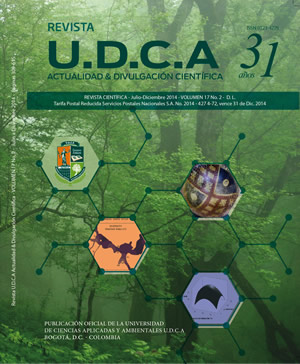Contenido de glucósidos en función de deficiencias nutricionales en Stevia rebaudiana Bert.
Glycoside contents depending on the nutrient deficiencies in Stevia rebaudiana Bert.
Contenido principal del artículo
Resumen
A nivel mundial, los reportes de los requerimientos nutricionales de estevia (Stevia rebaudiana Bert.), así como de los efectos que las deficiencias de los elementos minerales tienen sobre el contenido de los principales edulcorantes de la hoja, son escasos. El presente trabajo, se realizó en Casa de Vegetación de la Facultad de Ciencias Agrícolas, de la Universidad de Córdoba (Montería, Colombia), con el objetivo de determinar el efecto de las deficiencias nutricionales de N, P, K, Ca, S, Mg, Fe, B, Cu y Zn sobre la concentración de glucósidos totales de la hoja de estevia y, en particular, del rebaudiósido A (RebA), en el genotipo Morita 2. Así mismo, se determinó quincenalmente el contenido de N, P, K, Ca y Mg de raíces, de tallo y de hojas en dos genotipos: Morita 1 (M1) y Morita 2 (M2), hasta el inicio de floración y se estimó la extracción de estos elementos, para una siembra comercial. Los resultados más relevantes indicaron que la concentración de glucósidos totales no se afectó por las deficiencias de nutrientes, aunque la concentración de RebA sólo se redujo ante deficiencias de P, S, K y Cu. La distribución diferencial de los elementos mayores en los órganos de la planta permitió establecer la extracción de estos en kg/ha, que fue respectivamente para M1 y M2 de 24,9 y 30,8 (N); 4,8 y 6,3 (P); 23,7 y 29,9 (K); 9,7 y 10,8 (Ca) y 6,7 y 6,3 (Mg).
Palabras clave:
Descargas
Datos de publicación
Perfil evaluadores/as N/D
Declaraciones de autoría
- Sociedad académica
- Universidad de Ciencias Aplicadas UDCA
- Editorial
- Universidad de Ciencias Aplicadas y Ambientales U.D.C.A
Detalles del artículo
Referencias (VER)
ALLAM, A.I.; NASSAR, A.M.; BESHEIT, S.Y. 2001. Nitrogen fertilizer requirements of Stevia rebaudiana (Bert.) Bertoni under Egyptian conditions. Egypt. J. Agric. Res. 79(3):1005-1018.
ÁLVAREZ-GARCÍA, R.; TORRES-VALENCIA, J.; ROMÁN, L.; HERNÁNDEZ, J.; CERDA-GARCÍA-ROJAS, C.; JOSEPH-NATHAN, P. 2005. Absolute configuration of the a-methylbutyryl residue in longipinene derivatives from Stevia pilosa. Phytochem. 66:639- 642.
AZCÓN-BIETO, J.; TALÓN, M. 2008. Fundamentos de Fisiologia Vegetal, 2? Ed. McGraw-Hill - Interamericana de España. S.A.U. y. Publicacions y Edicions de la Universitat de. Barcelona, 651p.
BARATHI, N. 2002. Stevia-A way to sweeten life. Disponible desde internet en: http://www. growmorebiotech.com/article1.htm. (con acceso 11/02/2011).
BONDAREV, N.; RESHETNYAK, O.; NOSOV, A. 2003. Effects of nutrient medium composition on development of Stevia rebaudiana shoots cultivated in the roller bioreactor and their production of steviol glycosides. Plant Sci. 165:845-850.
BRANDLE, J.E.; TELMER, P.G. 2007. Steviol glycoside biosynthesis. Phytochem. 68:1855-1863.
BRANDLE, J.E. 1999. Genetic control of rebaudioside A and C concentration in leaves of the sweet herb, Stevia rebaudiana. Can. J. Plant Sci. 79(1):85-92.
BRANDLE, J.E.; RICHMAN, A.; SWANSON, A.; CHAPMAN, B. 2002. Leaf ESTs from Stevia rebaudiana: a resource for gene discovery in diterpene synthesis. Plant Mol. Biol. 50:613-622.
CARAKOSTAS, M.C.; CURRY, L.L.; BOILEAU, A.C.; BRUSICK, D.J. 2008. Overview: The history, technical function and safety of rebaudioside A, a naturally occurring steviol glycoside, for use in food and beverages. Food Chem. Tox. 46: S1-S10.
DACOME, A.; DA SILVA, C.; DA COSTA, C.; FONTANA, J.; ADELMANN, J.; DA COSTA, S. 2005. Sweet diterpenic glycosides balance of a new cultivar of Stevia rebaudiana (Bert.) Bertoni: Isolation and quantitative distribution by chromatographic, spectroscopic, and electrophoretic methods. Process Biochem. 40:3587-3594.
DAS, K.; DANG, R.; SHIVANANDA, T.N.; SEKEROGLU, N. 2007. Influence of bio-fertilizers on the biomass yield and nutrient content in stevia (Stevia rebaudiana. Bert) grown in Indian subtropics. J. Med. Plants Res. 1(1):5-8.
DAS, K.; DANG, R.; SHIVANANDA, T.N. 2008. Influence of bio-fertilizers on the availability of nutrients (N, P and K) in soil in relation to growth and yield of Stevia rebaudiana grown in South India. Int. J. Appl. Res. Nat.l Prod. 1(1):20-24.
DE LIMA, O.; MALAVOLTA, E.; DE SENA, J.; CARNEIRO, J. 1997a. Absorção e Acumulação de Nutrientes em Estévia Stevia rebaudiana (Bert.) Bertoni: I. Macronutrientes. Sci. Agric., Piracicaba. 54(1/2):23- 30.
DE LIMA, O.; MALAVOLTA, E.; YABICO, H. 1997b. Influència de estresses nutricionais no teor e produçâo de esteviosídeo durante o desenvolvimento da Stevia. Pesquisa Agropec. Bras. 32(5):489-494.
DE LIMA, O.; MALAVOLTA, E. 1997. Sintomas de desordens nutricionais em estévia Stevia rebaudiana (Bert.) Bertoni. Sci. Agric. 54(1/2):53-61.
EPSTEIN, E.; BLOOM, A. 2005. Mineral nutrition of plants: principles and perspectives. Sinauer Associates (EUA). 400p.
ERKUCUK, A.; AKGUN, I.H.; YESIL-CELIKTAS, O. 2009. Supercritical CO2 extraction of glycosides from Stevia rebaudiana leaves: Identification and optimization. J. Supercr. Fluids. 51:29-35.
FAN, X.; SHEN, Q.; ZHU, H.; MA, Z.; YIN, X.; MILLER, A. 2005. A comparison of nitrate transport in four different rice (Oryza sativa L.) cultivars. Sci. China (Series C). 48:897-911.
FRONZA, D.; FOLEGATTI, M. 2003. Water consumption of the estevia (Stevia rebaudiana (Bert.) Bertoni) crop estimated through microlysimeter. Sci. Agric. 60(3):595-599.
GARDANA, C.; SCAGLIANTI, M.; SIMONETTI, P. 2010. Evaluation of steviol and its glycosides in Stevia rebaudiana leaves and commercial sweetener by ultra high performance liquid chromatographymass spectrometry, J. Chromatogr. 1217(9):1463-1470.
GEUNS, J.M. 2003. Stevioside. Phytochem. 64:913-921.
HEARN, L.K.; SUBEDI, P.P. 2006. Determining levels of steviol glycosides in the leaves of Stevia rebaudiana by near infrared reflectance spectroscopy. J. Food Compos. Anal. 22:165-168.
JARMA, A. 2008. Estudios de adaptación y manejo integrado de estevia (Stevia rebaudiana Bert.): nueva alternativa agroindustrial del Caribe colombiano. Una revisión. Rev. Col. Sc. Hort. 2(1):109-120.
LIU, J.; JIN-WEI, L.; JIAN, T. 2010. Ultrasonically assisted extraction of total carbohydrates from Stevia rebaudiana Bertoni and identification of extracts. Food Bioprod. Process. 88(2-3):215-221.
MARSCHNER, H. 2002. Mineral nutrition of higher plants. 2nd ed. Academic Press. 889p.
MIDMORE, D.; RANK, A. 2002. A new rural industry - Stevia - to replace imported chemical sweeteners. Rural Industries Research and Development Corporation (RIRDC), Kingston, Australia. 55p.
MIZUKAMI, H.; SHIBA, K.; OHASHI, H. 1983. Effect of temperature on growth and stevioside formation of Stevia rebaudiana. Shoyakugaku Zasshi. 37:175- 179.
NEPOVIM, A.; DRAHOSOVA, H.; VALICEK, V.; VANEK, T. 1998. The effect of cultivation conditions on the content of stevioside in Stevia rebaudiana Bertoni plants cultivated in the Czech Republic. Pharmaceut. Pharmacol Lett. 8:19-21.
RAMESH, K.; SINGH, V.; MEGEJI, N.W. 2006. Cultivation of stevia [Stevia rebaudiana (Bert.) Bertoni]: A comprehensive review. Adv. in Agron. 89:137-177.
RICHMAN, A.; SWANSON, A.; HUMPHREY, T.; CHAPMAN, R.; MCGARVEY, B.; POCS, R.; BRANDLE, J. 2005. Functional genomics uncovers three glucosyltransferases involved in the synthesis of the major sweet glucosides of Stevia rebaudiana. Plant J. 41:56-67.
SRIVASTAVA, L.M. 2002. Plant growth and development. Hormones and environment. Academic Press, Amsterdam. 772p.
SU, J.; XIAO, M.; LI, Q.; LIU, B.; TONG, T. 2006. Mapping QTLs for phosphorus-deficiency tolerance at wheat seedling stage. Plant and Soil. 281(1-2):25-36.
TAIZ, L.; ZEIGER, E. 2006. Plant Physiology. IV ed. Sinauer Associates, Inc. p.75-83.
UTUMI, M.; MONNERAT, P.; GOMES, P.; RESENDE, P.; CAMPOS, V. 1999. Deficiência de macronutrientes em estévia: Sintomas visuais e efeitos no crescimento, Composição química e produção de esteviosídeo. Pesq. Agropec. Bras. 34(6):1039-1043.
WHITE, P.; BROADLEY, M. 2003. Calcium in plants. Ann. Bot. 92:487-511.







